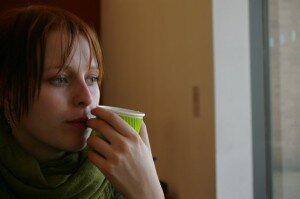Altogether I’ve spent about 3 years in Europe since 2002, but I’ve never been in one place to watch the whole transition from deep winter to spring before.
It’s been a lovely couple of weeks here in Berlin. From the first day of April the sun started shining and people started smiling. Then the most amazing thing happened, the horse chestnut tree (Rosskastaniene) in the courtyard (hof) began to change from branches with buds to a tree with leaves. Sure, trees get leaves every spring, but from my regular typing place by the kitchen window I finally could pay attention to the process.
Let me tell you something fascinating, trees burst into leaf from the bottom up. Over three days I could effectively see the sap flowing up the trunk and along the branches. From hour to hour different leaves had opened and I kinda forgot to take photos of the process because I kept on saying to my flatmate “Can you see that? It’s like a switch has been turned on or something!”
It was pretty exciting.
Here’s a photo from today, two weeks after the leaves unfurled:
The season actually appeared to burst from tree branch, bulb, seed and sun. I guess that’s why it’s called spring?
I needed to live in Europe before I understood that in my part of Australia, the seasons of Spring, Summer, Autumn and Winter are Euro-centric ideas laid on top of a vastly different climate. Even though it would make more sense to acknowledge traditional indigenous seasons, we persist in describing Australian weather with concepts that don’t adequately describe the actual seasonal patterns. I feel that one of the reasons discussions about climate change fail to influence people, is because a large part of the developed (and emitting) world’s population is semantically isolated from what is normal for their region.
Because of the ways in which language and culture are transmitted, the experience of being an Austrlian in Europe (and more specifically Britain) is that of normality: birds whistle familiar sounding melodies, trees are the shape of picture book trees and some houses are actually shaped like childrens’ generic house drawings. It may be ‘normal’ here, but however lovely Berlin in Spring may be, thinking about the contrasts makes me miss and desire the strange shapes, sounds and smells of South Australia, the experiences that I grew up in.
I think the black and white local magpies (Eltern) with their kleptomanic tendencies and dark blue flash of wing are quite beautiful, but there’s something about the sound of Australian magpies which makes up for their more violent tendency to swoop and attack while nesting [mp3].
 by
by
The thing I most heartwrenchingly miss has always been the rainbow lorikeet, its swooping flash of colour as it flies through my favourite park and the chatter a flock of them make around dusk [the latter third of this mp3]. When I lived in Finland and made my garden wall, I painted a lorikeet to live in the plants. If I could be reborn as an animal I’d be a lorikeet.
I had intended this to be more of a post about how marvellous the weather has been, rather than a meditation on climate, language, postcolonialism and the strange experience of being a European (Australian) “other” in Europe. Inevitably though, the feelings associated with new locations, travel and identity lead to a specific feeling of missing what is first known and familiar.

